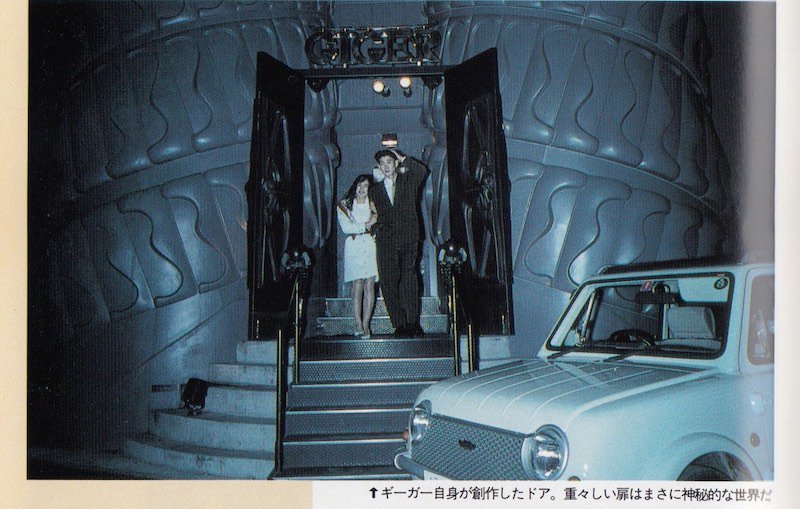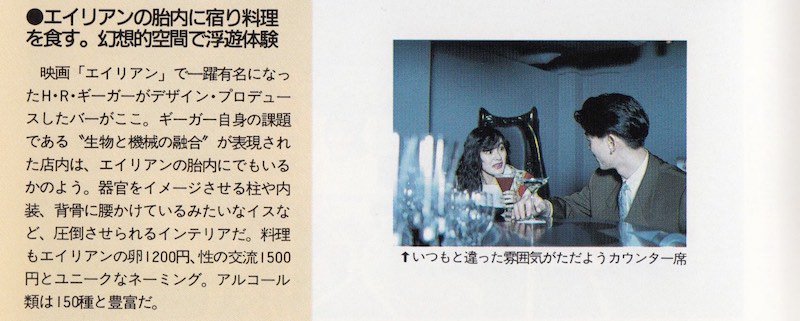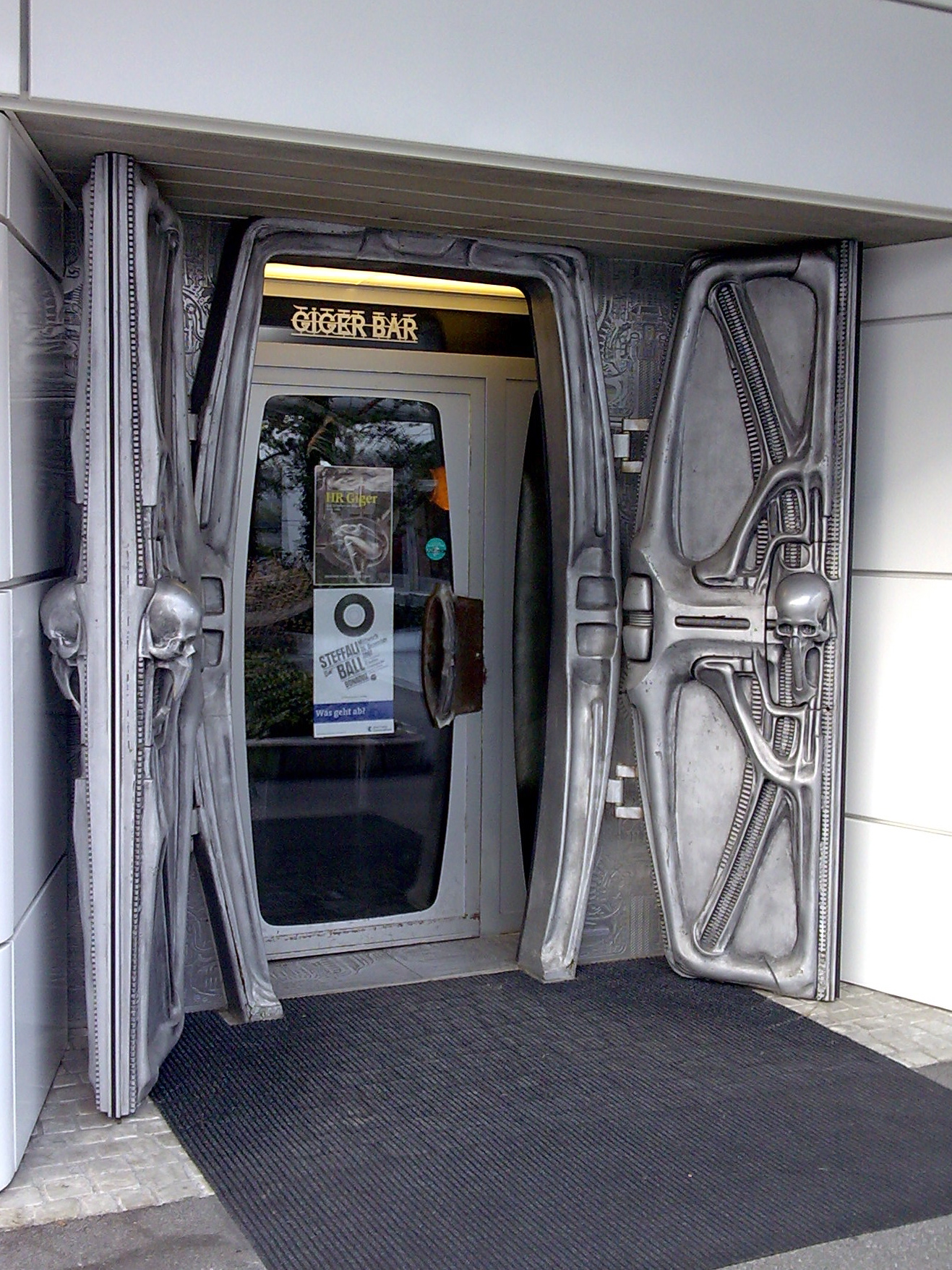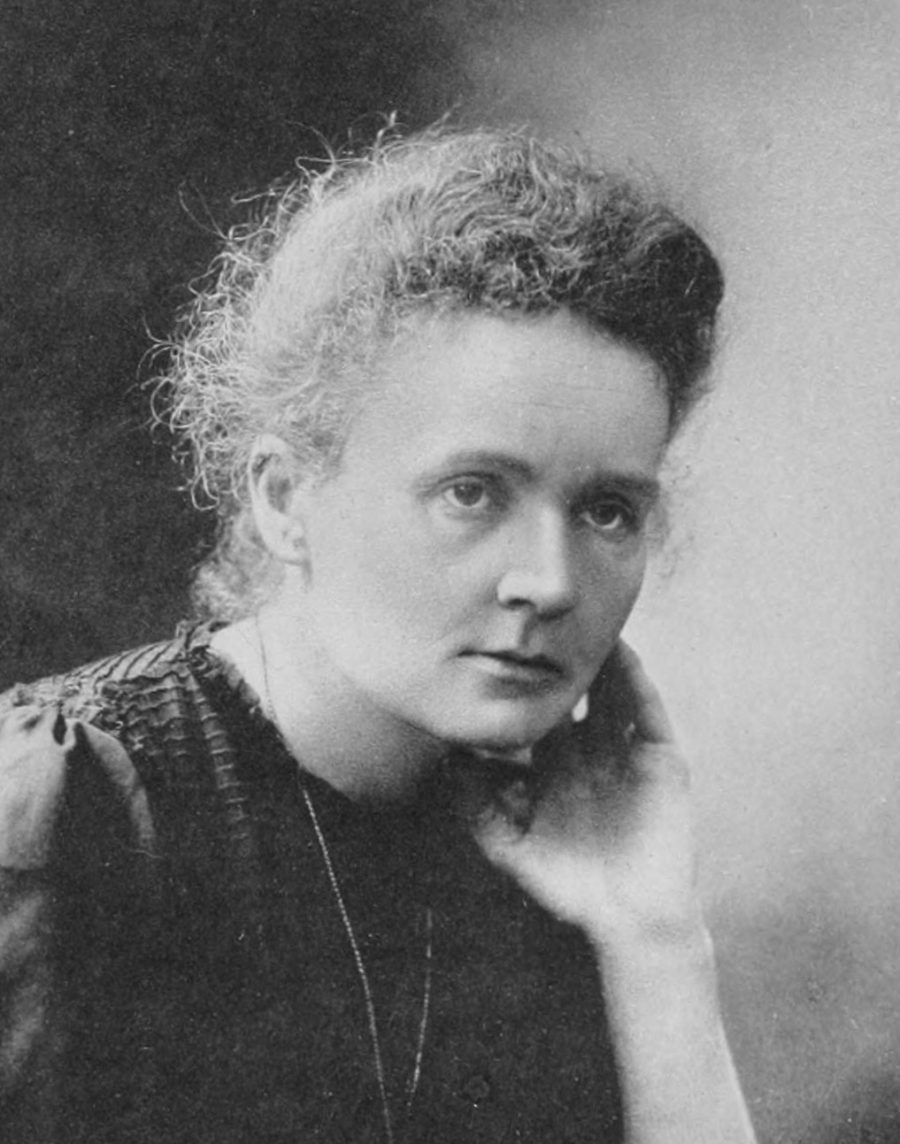[Most Recent Entries] [Calendar View]
Tuesday, June 4th, 2019
| Time | Event |
| 8:00a | The Giger Bar: Discover the 1980s Tokyo Bar Designed by H. R. Giger, the Same Artist Who Created the Nightmarish Monster in Ridley Scott’s Alien
In 1980s Tokyo, everything was possible — or at least everything was tried out. Having developed feverishly since the end of the Second World War, Japan had by that point inflated an asset bubble so enormous that, so the story goes, the land on which the Imperial Palace stands was worth more than all of California. Many Japanese felt rich, and upwardly mobile young Tokyoites felt much more so; in the capital sprung up countless establishments aiming to cash in on their willingness and ability to spend their new money on experiences, especially experiences slick, expensive, and exotic.
And for the highest-rolling young Tokyoites of the 1980s, consumers for whom pieces of America and Europe wouldn't be exotic enough, there was the Giger Bar. Writer on Japanese culture W. David Marx recently tweeted out a few magazine clippings to do with one of what he calls the "hot yuppie date spots in Tokyo, 1989: GIGER BAR Bring your date to the Tokyo bar designed by Swiss artist H. R. Giger of Alien fame, where 'the atmosphere differs from the usual.' 'alien eggs' on the menu at ¥1200, and something called 'sexual communion' for ¥1500."
"The Giger Bar in Tokyo was actually created against my will," Giger himself wrote in 1997. "While I was in Tokyo, I was asked to make a wish, on stage, during a press conference. Spontaneously, I wished for a bar, which was then brought into being even more spontaneously!" For that bar, Giger designed "tables-for-two in open elevator cars in the manner of gliding elevators that would travel up and down the four-story establishment, perpetually in motion." But he hadn't taken into consideration the rigidity of Japanese fire marshals, and already "driven to the brink of madness" by the country's complex earthquake-related building codes, Giger ultimately stepped back from his design role.
Giger also hadn't foreseen the fact that his namesake Japanese bar "was tailor-made for the underworld." Five years after the bar opened, a friend visited and told Giger that "it had fallen into the hands of the Yakuza. He went on to report that he was alone in the bar until 11 o'clock, when it began to fill with the type of unsavory characters who might have installed a roulette table in the atrium." By the time Giger wrote this reflection, the Tokyo Giger Bar had closed its doors entirely: "Insiders know that a bar in Tokyo rarely survives more than five years!"
But two other Giger Bars live on, not in Japan but in Giger's native Switzerland, one in his hometown of Chur (originally planned for New York City, a location that proved too expensive for the elaborate design) and the other in Gruyères (adjacent to the H.R. Giger Museum). Those Swiss branches, a couple pictures of which appear above, carry on the Giger Bar's aesthetic in a manner seemingly more faithful to the artist's grotesque biomechanical visions than did the Tokyo branch. Whether this could ever prove a sustainable nightlife concept elsewhere in the world remains to be seen, but as Giger's hardcore fans — the kind who wouldn't hesitate to make the Giger Bar pilgrimage to Switzerland — might well ask, who wouldn't want to have a drink in the womb of the alien queen? Related Content: A Photographic Tour of Haruki Murakami’s Tokyo, Where Dream, Memory, and Reality Meet High School Kids Stage Alien: The Play and You Can Now Watch It Online Based in Seoul, Colin Marshall writes and broadcasts on cities, language, and culture. His projects include the book The Stateless City: a Walk through 21st-Century Los Angeles and the video series The City in Cinema. Follow him on Twitter at @colinmarshall, on Facebook, or on Instagram. The Giger Bar: Discover the 1980s Tokyo Bar Designed by H. R. Giger, the Same Artist Who Created the Nightmarish Monster in Ridley Scott’s Alien is a post from: Open Culture. Follow us on Facebook, Twitter, and Google Plus, or get our Daily Email. And don't miss our big collections of Free Online Courses, Free Online Movies, Free eBooks, Free Audio Books, Free Foreign Language Lessons, and MOOCs. |
| 2:00p | Exercise May Prove an Effective Natural Treatment for Depression & Anxiety, New Study Shows
Image by cuegalos, via Flickr Commons Maybe it seems intuitive that exercise would be prescribed to treat anxiety and depression, lower stress levels, and make people happier. After all, exercise and nutritional interventions are regularly discussed in the context of the U.S.’s other major killers: heart disease, diabetes, various cancers, even Alzheimer’s. How often have we heard about the dangers of a sedentary lifestyle or over-processed foods? Or read about remedies from walking, yoga, and spin cycling to the Mediterranean diet? But mental health is seemingly different—the disease model that guided depression research for so long has faltered. “We do not have a biology for mental illness,” writes Derek Beres at Big Think. Researchers lack a medical pathology for mood disorders that affect overall health, careers, relationships, and quality of life for millions. The antidepressants once sold as a cure-all and prescribed to dizzying degrees proved to have limited efficacy and unfortunate side effects. No one seems to know exactly how or why or if they work. “Mental health scripts are guesswork,” Beres writes, “more of an art than science.” Where does this leave the state of mental health research these days? One team of scientists at the University of Vermont found evidence that exercise significantly improved mood in patients with severe and chronic mental illnesses. As Newsweek reports, “a total of 100 patients signed up to participate in the study,” whose results were published recently in the journal Global Advances in Health and Medicine. The study volunteers came from “wards that dealt with conditions such as bipolar disorder, depression, borderline personality disorder, generalized anxiety disorder and schizophrenia.” After a workout schedule that included cardio, resistance, and flexibility training, four times a week for sixty minutes at a time, as well as nutritional programs “tailored” for each patient, 95 percent of the participants “said their mood has improved… and 63 percent said they were ‘happy’ or ‘very happy,’ rather than ‘neutral,’ ‘sad,’ or ‘very sad.’” 97.6 said they were motivated to continue working out and eating better. “The research yielded positive outcomes in all areas investigated,” write authors David Tomasi, Sheri Gates, and Emily Reyns of the study’s results. They conclude that physical exercise may contribute to “a more balanced and integrated sense of self.” The researchers also recommend exercise as a treatment before the prescription of psychiatric drugs. There may not yet be a clear medical explanation for why it works. But that may be because modern medicine has only recently begun to see the mind and the body as one, at a time when our cultural evolution sends us hurtling toward a greater artificial divide between the two. “We’ve constructed a world in which most of the population survives by performing minimal physical activity.” A world soon to be engulfed in VR, AR, self-driving cars, and an “internet of things” that promises to eliminate the few physical tasks we have left. We are in danger of forgetting that our mental and emotional health are directly tied to the needs of our physical bodies, and that our bodies need to move, stretch, and bend in order to stay alive and thrive. Read more summary of the study at Newsweek and see the full results from Global Advances in Health and Medicine here. Related Content: What’s a Scientifically-Proven Way to Improve Your Ability to Learn? Get Out and Exercise How Stress Can Change Your Brain: An Animated Introduction Josh Jones is a writer and musician based in Durham, NC. Follow him at @jdmagness. Exercise May Prove an Effective Natural Treatment for Depression & Anxiety, New Study Shows is a post from: Open Culture. Follow us on Facebook, Twitter, and Google Plus, or get our Daily Email. And don't miss our big collections of Free Online Courses, Free Online Movies, Free eBooks, Free Audio Books, Free Foreign Language Lessons, and MOOCs. |
| 5:04p | Watch the First Trailer for Martin Scorsese’s New Film, Rolling Thunder Revue: A Bob Dylan Story Rolling Thunder Revue: A Bob Dylan Story "captures the troubled spirit of America in 1975, and the joyous music that Bob Dylan performed that fall [during the Rolling Thunder Revue tour]. Master filmmaker Martin Scorsese creates a one-of-a-kind movie experience: part documentary, part concert film, part fever dream. Featuring Joan Baez, Rubin Hurricane Carter, Sam Shepard, Allen Ginsberg, and Bob Dylan giving his first on-camera interview in over a decade. The film goes beyond mere reclamation of Dylan’s extraordinary music—it’s a roadmap into the wild country of artistic self-reinvention." Watch the brand new trailer above, and mark June 12th on your calendar when the film arrives on Netflix. Relatedly, June 7th is when Dylan will release The Rolling Thunder Revue: The 1975 Live Recordings, a 14CD box set that features all five sets from the Rolling Thunder Revue tour that were professionally recorded. Would you like to support the mission of Open Culture? Please consider making a donation to our site. It's hard to rely 100% on ads, and your contributions will help us continue providing the best free cultural and educational materials to learners everywhere. Also consider following Open Culture on Facebook and Twitter and sharing intelligent media with your friends. Or sign up for our daily email and get a daily dose of Open Culture in your inbox. Related Content: Tangled Up in Blue: Deciphering a Bob Dylan Masterpiece Watch Joan Baez Endearingly Imitate Bob Dylan (1972) Hear Bob Dylan’s Newly-Released Nobel Lecture: A Meditation on Music, Literature & Lyrics Watch the First Trailer for Martin Scorsese’s New Film, Rolling Thunder Revue: A Bob Dylan Story is a post from: Open Culture. Follow us on Facebook, Twitter, and Google Plus, or get our Daily Email. And don't miss our big collections of Free Online Courses, Free Online Movies, Free eBooks, Free Audio Books, Free Foreign Language Lessons, and MOOCs. |
| 8:00p | Marie Curie Became the First Woman to Win a Nobel Prize, the First Person to Win Twice, and the Only Person in History to Win in Two Different Sciences
When systematic discrimination limits opportunities for any group, those who do receive recognition, the exceptions to the rule, must often be truly exceptional to succeed. There has been little doubt, both in her lifetime and in the many decades afterward, that Marie Curie was such a person. Although forced to study science in secret at a clandestine “Floating University” in her native Poland—since the universities refused to admit women—Curie (born Marie Salomea Sklodowska in 1867) would achieve such renown in her field that she was awarded not one, but two Nobel Prizes. Curie and her husband Pierre shared the Nobel Prize in Physics with Antoine Henri Becquerel, discoverer of radioactivity, in 1903. The second prize, in Chemistry, was hers alone in 1911, “in recognition of her services to the advancement of chemistry by the discovery of the elements radium and polonium, by the isolation of radium and the study of the nature and compounds of this remarkable element.” Curie was not only the first woman to win a Nobel, but she was also the first person to win twice, and the only person to win in two different sciences. These are but a handful of achievements in a string of firsts for Curie: denied positions in Poland, she earned a Ph.D. in France, awarded the degree in 1903 by the Sorbonne, the same year she won her first Nobel. “Her examiners,” notes the site Famous Scientists, “were of the view that she had made the greatest contribution to science ever found in a Ph.D. thesis.” Three years later, after Pierre was killed in an accident, Marie was offered his professorship and became the first female professor at the University of Paris. Curie succeeded not in the absence of, but in spite of the sexist obstacles placed in her path at nearly every stage in her career. After she received her doctorate, the Curies were invited to the Royal Institution in London. Only Pierre was permitted to speak. That same year, the Nobel Committee decided to honor only her husband and Becquerel. The Academy relented when Pierre protested. Curie fell victim to a wave of xenophobia and anti-Semitism (though she was not Jewish) that swept through France in the 1900s, most famously in the so-called “Dreyfus Affair.” In 1911, the year of her second Nobel, Curie was passed over for membership in the French Academy of Sciences. It would take another 51 years before the first woman, Marguerite Perey, a former doctoral student of Curie, would be elected to that body. That same year, Curie was persecuted relentlessly by the French press, the public, and her scientific rivals after it was revealed that she had had a brief affair with physicist Paul Langevin, one of Pierre Curie’s former students. But no matter how many men in positions of power wanted to deter Curie, there always seemed to be more influential scientists and politicians who recognized the supreme value of her work and the need to help her continue it. After her second Nobel Prize, her native country finally recognized her with the offer to direct her own laboratory in Warsaw. Curie turned it down to focus on directing the Curie Laboratory in the Radium Institute of the University of Paris, which she founded in 1914, a major achievement and, again, only a small part of her legacy. Curie is known, of course, foremost for her exceptional scientific work, but also for opening doors for women in science all over the world, though much of that door-opening may only have happened decades after her death in 1934, and much of it hasn’t happened at all yet. Incidentally, in the following year, the Curies’ daughter Irène Joliot-Curie and her husband Frédéric Joliot-Curie were jointly awarded the Nobel Prize in Chemistry. Since then, only two other women have claimed that honor, and only two women, including Marie Curie, have won the Prize in physics, out of 203 winners total. There may be nothing yet like gender parity in the sciences, but those who know where to look can find the names of dozens of women scientists running women-owned companies, women-founded research institutes and academic departments, and, like the famous Curies, making major contributions to chemistry. Perhaps not long from now, many of those exceptional scientists will be as well-known and widely celebrated as Marie Curie. Related Content: Josh Jones is a writer and musician based in Durham, NC. Follow him at @jdmagness Marie Curie Became the First Woman to Win a Nobel Prize, the First Person to Win Twice, and the Only Person in History to Win in Two Different Sciences is a post from: Open Culture. Follow us on Facebook, Twitter, and Google Plus, or get our Daily Email. And don't miss our big collections of Free Online Courses, Free Online Movies, Free eBooks, Free Audio Books, Free Foreign Language Lessons, and MOOCs. |
| << Previous Day |
2019/06/04 [Calendar] |
Next Day >> |







